European Travels: Krakow (for Zhyds)
The other day I went to a talk by an applied anthropologist who recently wrote a book on anthropologists working for the Third Reich, and the relationship between their "scientific objectivity" and racial profiling and policies that sent people directly to their deaths. It was deeply disturbing, as you might imagine, in particular her stories of being stonewalled at various European institutes and archives, of being just the fourth person since 1945 to read the Jewish archives in Lodz, Poland (that's pronounced "woodzh", by the way), and of being confronted with shelf upon shelf of skulls of concentration camp victims that had been carefully packaged and shipped back to an institute in Vienna that is storing them in a back room to this day. Her tale was one of denial of culpability (e.g., American funding agencies gave money to institutional projects that led directly to experiments led by Josef Mengele but no one ever talks about this, and none of the German anthropologists in question were punished in any significant way) and erasure of collective memory. Defining people as subhuman seems to really take the anthropo- right out of anthropology, you know? I talked to her afterwards about my own experiences in Poland this summer, especially with regards to erasure of collective memory, and it made me think that perhaps it is time for Episode Two in my Polish travelogue, here focusing on the more Jewish aspect of Krakow.
Upon arrival, my first impressions of Krakow were really quite positive, especially when compared to the three Russian cities I've spent time in, and in my travel notes I have a brief list of ways that Poland seems to be functioning a bit better than post-Soviet Russia: smiling and friendly cashiers and serving people, no breakfast beer, no hordes of stray cats and dogs, people actually pick up after their dogs, hip teens look like they could be in any European city. But a day or two into my visit, a colleague pointed out that people on the street were staring at me all the time. At first I didn't believe her, but then I saw it was true, and couldn't for the life of me figure out why -- I wasn't even dressed weirdly or anything, especially when compared to local hipsters with dreadlocks and nose rings. "Pangeaochka," she said (using the Russian diminutive of my real name), "it must be your exotic good looks." Of course I was immediately dismissive, especially since a good-looking Polish woman is really good looking, and they were everywhere. But then I began to focus on the word "exotic," and decided that (1) that was probably the key, and (2) it was pretty depressing. So the staring, all the time that I was out on the streets, began to feel incredibly oppressive because of this fact: there should be, right now, a large local population that looks exactly like me, especially as some of them would in fact be my blood relatives. But they are all dead or gone. And if they were around, I wouldn't look exotic at all, I would just look like a lot the other Jews walking around town (if a bit darker than most). So every stare, regardless of intent or reason, began to remind me that I was there when others were not, and started to make me feel a bit like a ghostly presence, someone who feels like she belongs in a place and has a right to be there, except for the fact that she doesn't actually belong there anymore.
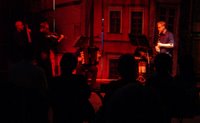 So I went to the Kazimierz, the Jewish quarter of town -- Jews were moved there in 1495, but this is not the Jewish ghetto of the war, which was located elsewhere in the city. The Kazimierz is a part of the city that has recently begun gentrifying in two ways, with cafes and nightclubs catering to the local youth and elite, and with nostalgic Jewish restaurants and stores catering to the streams of American and Israeli Jews coming back for heritage visits (one statistic I read says that half of the world's Jews have some historical connection to the land that is currently Poland). Amidst the gentrification are crumbling old apartment buildings and commercial spaces, reflecting the fact that the neighborhood was a pretty undesirable part of town until really quite recently. Seeing Jewish history appropriated and commodified for the tourist trade was pretty strange, and I'm still ambivalent. For example, the band playing in that photo above is an all-Polish klezmer band filled with classically trained musicians who would walk each day from their dorm through the Kazimierz en route to the conservatory. And they started playing klezmer music, partly for commercial reasons (this was a gig at a Jewish museum, one of many shows they were playing that month), but partly because they said they felt drawn to the music, that it called to them. They seemed to me a lot like white musicians playing jazz or white kids who become rappers, and I was reminded of the Klezmatics concert I went to with J-ka last summer in Prague, where dreadlocked hippies and skinhead-looking punks danced with great joy, completely unironically. Is it that victimhood lends itself to appropriation and coolness? Maybe just when the music is good.
So I went to the Kazimierz, the Jewish quarter of town -- Jews were moved there in 1495, but this is not the Jewish ghetto of the war, which was located elsewhere in the city. The Kazimierz is a part of the city that has recently begun gentrifying in two ways, with cafes and nightclubs catering to the local youth and elite, and with nostalgic Jewish restaurants and stores catering to the streams of American and Israeli Jews coming back for heritage visits (one statistic I read says that half of the world's Jews have some historical connection to the land that is currently Poland). Amidst the gentrification are crumbling old apartment buildings and commercial spaces, reflecting the fact that the neighborhood was a pretty undesirable part of town until really quite recently. Seeing Jewish history appropriated and commodified for the tourist trade was pretty strange, and I'm still ambivalent. For example, the band playing in that photo above is an all-Polish klezmer band filled with classically trained musicians who would walk each day from their dorm through the Kazimierz en route to the conservatory. And they started playing klezmer music, partly for commercial reasons (this was a gig at a Jewish museum, one of many shows they were playing that month), but partly because they said they felt drawn to the music, that it called to them. They seemed to me a lot like white musicians playing jazz or white kids who become rappers, and I was reminded of the Klezmatics concert I went to with J-ka last summer in Prague, where dreadlocked hippies and skinhead-looking punks danced with great joy, completely unironically. Is it that victimhood lends itself to appropriation and coolness? Maybe just when the music is good.
For whatever reason, I don't have any pictures of the cloyingly nostalgic and very erastz-feeling restaurant row in the main square of the quarter. This here is actually a quite cute cafe on Ulica Izaaka (that 'c' is pronounced [ts], ulica = 'street'), which my friend liked because the sewing machines are presented on top of the tables, as opposed to underneath, the way they are in hipster cafes over here.
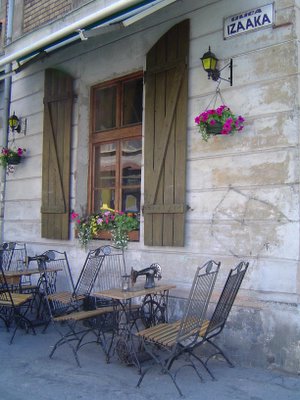 Just down the street is the Synagoga Izaaka, one of the main synagogues and now a museum (all the synagogues-turned-museums were staffed by Poles). This is a baroque synagogue, built in the mid-17th century (financed by a guy named Isaac, hence the name), and basically looted and destroyed during the occupation. Despite the cheesy movie on the monitor and equally cheesy music piped into the building, I found it deeply moving. The first photo shows the front of the sanctuary, with the ark for the torah scrolls, and the second shows the back of the sanctuary, with the entrance and the women's gallery above it. (Can't have the temptresses down there with the men!)
Just down the street is the Synagoga Izaaka, one of the main synagogues and now a museum (all the synagogues-turned-museums were staffed by Poles). This is a baroque synagogue, built in the mid-17th century (financed by a guy named Isaac, hence the name), and basically looted and destroyed during the occupation. Despite the cheesy movie on the monitor and equally cheesy music piped into the building, I found it deeply moving. The first photo shows the front of the sanctuary, with the ark for the torah scrolls, and the second shows the back of the sanctuary, with the entrance and the women's gallery above it. (Can't have the temptresses down there with the men!)

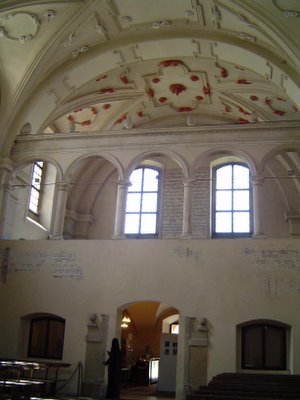 Some of the frescoes survived, though most were destroyed. This Hebrew, unlike modern Israeli Hebrew, has all the vowels and diacritics written out, so I can actually read it, though I only knew a few words. (So shameful, after all those years of Hebrew school!)
Some of the frescoes survived, though most were destroyed. This Hebrew, unlike modern Israeli Hebrew, has all the vowels and diacritics written out, so I can actually read it, though I only knew a few words. (So shameful, after all those years of Hebrew school!)
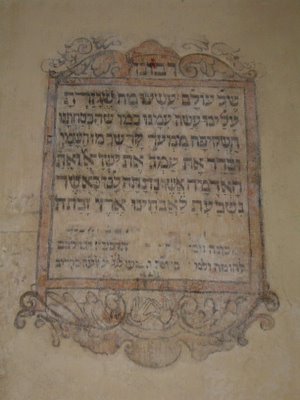
 At the bottom of the frescoes you see two hands in a position of prayer, with the first two and last two fingers held together and a gap in between. This is the hand position used when saying a prayer called the "Shema," which is considered central to Jewish worship, meant to be the first prayer taught to children and the last words said before death. Leonard Nimoy, raised orthodox, was intimate with the hand gesture involved, and used it for his Vulcan salutation. So it's not that the fresco painters were prescient Star Trek fans, just in case you were wondering.
At the bottom of the frescoes you see two hands in a position of prayer, with the first two and last two fingers held together and a gap in between. This is the hand position used when saying a prayer called the "Shema," which is considered central to Jewish worship, meant to be the first prayer taught to children and the last words said before death. Leonard Nimoy, raised orthodox, was intimate with the hand gesture involved, and used it for his Vulcan salutation. So it's not that the fresco painters were prescient Star Trek fans, just in case you were wondering.
This is the High Shul (shul = synagogue in Yiddish, it's cognate with "school"); turns out it was called "high" not because of its fanciness, but because it was up on the second floor.
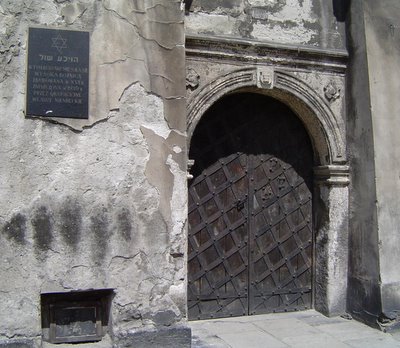 There are remnants of Jewish culture and life all throughout the Kazimierz, some with new commemorative plaques, like above, but others easily missed, with nearly illegible script and no explanations given.
There are remnants of Jewish culture and life all throughout the Kazimierz, some with new commemorative plaques, like above, but others easily missed, with nearly illegible script and no explanations given.
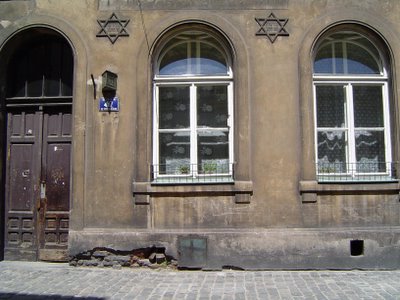
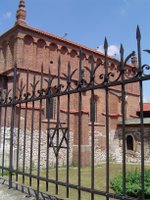
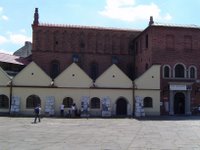 One of the more visited sites is the Stara Synagoga ('Old Synagogue'), which marks one boundary of the old district. This is one of two gothic synagogues in Europe -- the other is in Prague -- and is now a museum. Those are Israeli teens above, about to rejoin their bus tour: a common sight in summertime Krakow. By contrast, the tourists at Synagoga Remuh, below, were all older types, and at least based on looks, most likely not so Jewish. This temple actually has a small congregation once more, but I couldn't pop into Friday night services the way I wanted to, since we had a big faculty dinner in a Disneyesque Jewish klezmer restaurant across the street, or maybe it was more TGIFridays?, with various Jewish tchotchkes and pictures of rabbis and a rather elderly house band.
One of the more visited sites is the Stara Synagoga ('Old Synagogue'), which marks one boundary of the old district. This is one of two gothic synagogues in Europe -- the other is in Prague -- and is now a museum. Those are Israeli teens above, about to rejoin their bus tour: a common sight in summertime Krakow. By contrast, the tourists at Synagoga Remuh, below, were all older types, and at least based on looks, most likely not so Jewish. This temple actually has a small congregation once more, but I couldn't pop into Friday night services the way I wanted to, since we had a big faculty dinner in a Disneyesque Jewish klezmer restaurant across the street, or maybe it was more TGIFridays?, with various Jewish tchotchkes and pictures of rabbis and a rather elderly house band.
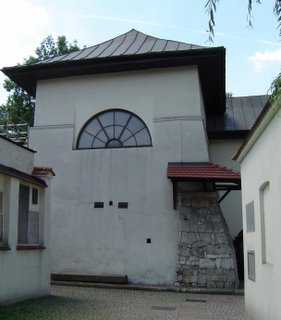 Synagoga Remuh is adjacent to a cemetery, and a wall filled with memorial plaques in many languages separates the two. No surprise that the ones I could read were as sad as could be, mostly from people who were the only survivors or children of the only survivors, who wanted to commemorate the entire families that had been lost, with numbers of murdered family members usually over 100.
Synagoga Remuh is adjacent to a cemetery, and a wall filled with memorial plaques in many languages separates the two. No surprise that the ones I could read were as sad as could be, mostly from people who were the only survivors or children of the only survivors, who wanted to commemorate the entire families that had been lost, with numbers of murdered family members usually over 100.
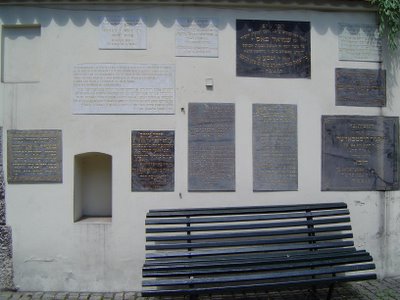 The mostly 19th-century gravestones themselves predate the war by decades at minimum, and were aesthetically quite pleasing.
The mostly 19th-century gravestones themselves predate the war by decades at minimum, and were aesthetically quite pleasing.
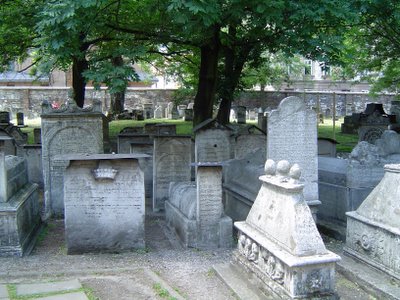 The headstones that survived were apparently under dirt at the time of the occupation, and so escaped notice.
The headstones that survived were apparently under dirt at the time of the occupation, and so escaped notice.
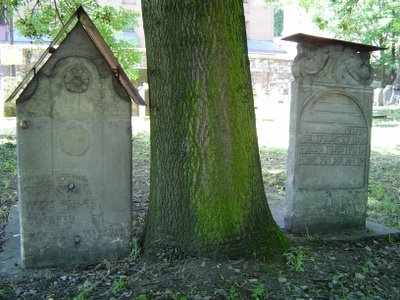 The ones that were above ground were smashed to bits by the Germans, and later reconstructed into a cemetery wall, which some call another "Wailing Wall," in analogy to the remaining outer wall of the ancient Temple in Jerusalem. More to cry about with this one, I think.
The ones that were above ground were smashed to bits by the Germans, and later reconstructed into a cemetery wall, which some call another "Wailing Wall," in analogy to the remaining outer wall of the ancient Temple in Jerusalem. More to cry about with this one, I think.
 Just down the street from the cemetery is the Synagoga Templu (seems a bit redundant), built by the association of "Progressive Jews" in the 1860s in a neo-Renaissance style. It is both fancy and shmancy, with ornate decoration everywhere, recently restored in extensive renovation.
Just down the street from the cemetery is the Synagoga Templu (seems a bit redundant), built by the association of "Progressive Jews" in the 1860s in a neo-Renaissance style. It is both fancy and shmancy, with ornate decoration everywhere, recently restored in extensive renovation.
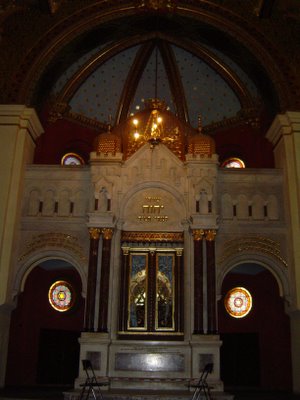 Even the ceiling is fancy.
Even the ceiling is fancy.
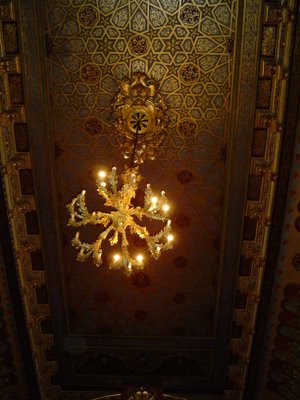 They were pretty clever, those Progressive Jews, and somehow made it so that the stained glass windows didn't show as stained glass from the outside, so they weren't subject to vandalism. They're beautiful with the flash on,
They were pretty clever, those Progressive Jews, and somehow made it so that the stained glass windows didn't show as stained glass from the outside, so they weren't subject to vandalism. They're beautiful with the flash on,
 but even cooler with the flash off.
but even cooler with the flash off.
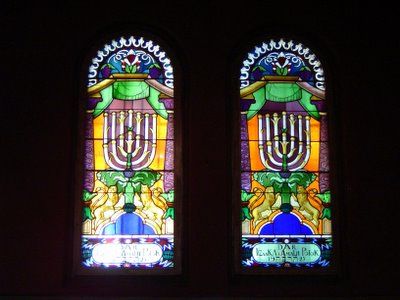 Finally, I leave you with this image, surreptitiously snapped at one of the souvenir carts in the main square in town. In the Kazimierz, there are all kinds of cutesy Jew dolls, with adorable little plump ceramic rabbis and skinny little serious rabbis being the main wares for sale. This one, in the center of the picture with the head mostly hidden by keychains, and being sold outside of the main Jewish tourist zone, doesn't have quite the same feel: the nose is hookier, he is clutching a real 1 grosz piece in his hands (equivalent to a penny), and over his arm is a sign, presumably in Yiddish but easily comprehensible to speakers of Polish, that says "Biznes is biznes." And there you have it.
Finally, I leave you with this image, surreptitiously snapped at one of the souvenir carts in the main square in town. In the Kazimierz, there are all kinds of cutesy Jew dolls, with adorable little plump ceramic rabbis and skinny little serious rabbis being the main wares for sale. This one, in the center of the picture with the head mostly hidden by keychains, and being sold outside of the main Jewish tourist zone, doesn't have quite the same feel: the nose is hookier, he is clutching a real 1 grosz piece in his hands (equivalent to a penny), and over his arm is a sign, presumably in Yiddish but easily comprehensible to speakers of Polish, that says "Biznes is biznes." And there you have it.
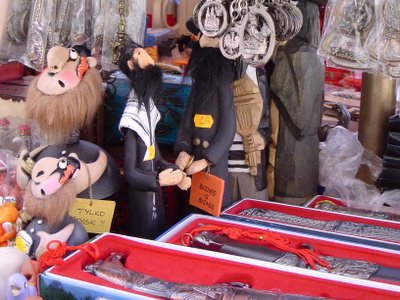 Next time, I'll cover my trip east out of Krakow to my grandmother's town, and my adventures there.
Next time, I'll cover my trip east out of Krakow to my grandmother's town, and my adventures there.
Upon arrival, my first impressions of Krakow were really quite positive, especially when compared to the three Russian cities I've spent time in, and in my travel notes I have a brief list of ways that Poland seems to be functioning a bit better than post-Soviet Russia: smiling and friendly cashiers and serving people, no breakfast beer, no hordes of stray cats and dogs, people actually pick up after their dogs, hip teens look like they could be in any European city. But a day or two into my visit, a colleague pointed out that people on the street were staring at me all the time. At first I didn't believe her, but then I saw it was true, and couldn't for the life of me figure out why -- I wasn't even dressed weirdly or anything, especially when compared to local hipsters with dreadlocks and nose rings. "Pangeaochka," she said (using the Russian diminutive of my real name), "it must be your exotic good looks." Of course I was immediately dismissive, especially since a good-looking Polish woman is really good looking, and they were everywhere. But then I began to focus on the word "exotic," and decided that (1) that was probably the key, and (2) it was pretty depressing. So the staring, all the time that I was out on the streets, began to feel incredibly oppressive because of this fact: there should be, right now, a large local population that looks exactly like me, especially as some of them would in fact be my blood relatives. But they are all dead or gone. And if they were around, I wouldn't look exotic at all, I would just look like a lot the other Jews walking around town (if a bit darker than most). So every stare, regardless of intent or reason, began to remind me that I was there when others were not, and started to make me feel a bit like a ghostly presence, someone who feels like she belongs in a place and has a right to be there, except for the fact that she doesn't actually belong there anymore.
 So I went to the Kazimierz, the Jewish quarter of town -- Jews were moved there in 1495, but this is not the Jewish ghetto of the war, which was located elsewhere in the city. The Kazimierz is a part of the city that has recently begun gentrifying in two ways, with cafes and nightclubs catering to the local youth and elite, and with nostalgic Jewish restaurants and stores catering to the streams of American and Israeli Jews coming back for heritage visits (one statistic I read says that half of the world's Jews have some historical connection to the land that is currently Poland). Amidst the gentrification are crumbling old apartment buildings and commercial spaces, reflecting the fact that the neighborhood was a pretty undesirable part of town until really quite recently. Seeing Jewish history appropriated and commodified for the tourist trade was pretty strange, and I'm still ambivalent. For example, the band playing in that photo above is an all-Polish klezmer band filled with classically trained musicians who would walk each day from their dorm through the Kazimierz en route to the conservatory. And they started playing klezmer music, partly for commercial reasons (this was a gig at a Jewish museum, one of many shows they were playing that month), but partly because they said they felt drawn to the music, that it called to them. They seemed to me a lot like white musicians playing jazz or white kids who become rappers, and I was reminded of the Klezmatics concert I went to with J-ka last summer in Prague, where dreadlocked hippies and skinhead-looking punks danced with great joy, completely unironically. Is it that victimhood lends itself to appropriation and coolness? Maybe just when the music is good.
So I went to the Kazimierz, the Jewish quarter of town -- Jews were moved there in 1495, but this is not the Jewish ghetto of the war, which was located elsewhere in the city. The Kazimierz is a part of the city that has recently begun gentrifying in two ways, with cafes and nightclubs catering to the local youth and elite, and with nostalgic Jewish restaurants and stores catering to the streams of American and Israeli Jews coming back for heritage visits (one statistic I read says that half of the world's Jews have some historical connection to the land that is currently Poland). Amidst the gentrification are crumbling old apartment buildings and commercial spaces, reflecting the fact that the neighborhood was a pretty undesirable part of town until really quite recently. Seeing Jewish history appropriated and commodified for the tourist trade was pretty strange, and I'm still ambivalent. For example, the band playing in that photo above is an all-Polish klezmer band filled with classically trained musicians who would walk each day from their dorm through the Kazimierz en route to the conservatory. And they started playing klezmer music, partly for commercial reasons (this was a gig at a Jewish museum, one of many shows they were playing that month), but partly because they said they felt drawn to the music, that it called to them. They seemed to me a lot like white musicians playing jazz or white kids who become rappers, and I was reminded of the Klezmatics concert I went to with J-ka last summer in Prague, where dreadlocked hippies and skinhead-looking punks danced with great joy, completely unironically. Is it that victimhood lends itself to appropriation and coolness? Maybe just when the music is good.For whatever reason, I don't have any pictures of the cloyingly nostalgic and very erastz-feeling restaurant row in the main square of the quarter. This here is actually a quite cute cafe on Ulica Izaaka (that 'c' is pronounced [ts], ulica = 'street'), which my friend liked because the sewing machines are presented on top of the tables, as opposed to underneath, the way they are in hipster cafes over here.
 Just down the street is the Synagoga Izaaka, one of the main synagogues and now a museum (all the synagogues-turned-museums were staffed by Poles). This is a baroque synagogue, built in the mid-17th century (financed by a guy named Isaac, hence the name), and basically looted and destroyed during the occupation. Despite the cheesy movie on the monitor and equally cheesy music piped into the building, I found it deeply moving. The first photo shows the front of the sanctuary, with the ark for the torah scrolls, and the second shows the back of the sanctuary, with the entrance and the women's gallery above it. (Can't have the temptresses down there with the men!)
Just down the street is the Synagoga Izaaka, one of the main synagogues and now a museum (all the synagogues-turned-museums were staffed by Poles). This is a baroque synagogue, built in the mid-17th century (financed by a guy named Isaac, hence the name), and basically looted and destroyed during the occupation. Despite the cheesy movie on the monitor and equally cheesy music piped into the building, I found it deeply moving. The first photo shows the front of the sanctuary, with the ark for the torah scrolls, and the second shows the back of the sanctuary, with the entrance and the women's gallery above it. (Can't have the temptresses down there with the men!)
 Some of the frescoes survived, though most were destroyed. This Hebrew, unlike modern Israeli Hebrew, has all the vowels and diacritics written out, so I can actually read it, though I only knew a few words. (So shameful, after all those years of Hebrew school!)
Some of the frescoes survived, though most were destroyed. This Hebrew, unlike modern Israeli Hebrew, has all the vowels and diacritics written out, so I can actually read it, though I only knew a few words. (So shameful, after all those years of Hebrew school!)
 At the bottom of the frescoes you see two hands in a position of prayer, with the first two and last two fingers held together and a gap in between. This is the hand position used when saying a prayer called the "Shema," which is considered central to Jewish worship, meant to be the first prayer taught to children and the last words said before death. Leonard Nimoy, raised orthodox, was intimate with the hand gesture involved, and used it for his Vulcan salutation. So it's not that the fresco painters were prescient Star Trek fans, just in case you were wondering.
At the bottom of the frescoes you see two hands in a position of prayer, with the first two and last two fingers held together and a gap in between. This is the hand position used when saying a prayer called the "Shema," which is considered central to Jewish worship, meant to be the first prayer taught to children and the last words said before death. Leonard Nimoy, raised orthodox, was intimate with the hand gesture involved, and used it for his Vulcan salutation. So it's not that the fresco painters were prescient Star Trek fans, just in case you were wondering.This is the High Shul (shul = synagogue in Yiddish, it's cognate with "school"); turns out it was called "high" not because of its fanciness, but because it was up on the second floor.
 There are remnants of Jewish culture and life all throughout the Kazimierz, some with new commemorative plaques, like above, but others easily missed, with nearly illegible script and no explanations given.
There are remnants of Jewish culture and life all throughout the Kazimierz, some with new commemorative plaques, like above, but others easily missed, with nearly illegible script and no explanations given.

 One of the more visited sites is the Stara Synagoga ('Old Synagogue'), which marks one boundary of the old district. This is one of two gothic synagogues in Europe -- the other is in Prague -- and is now a museum. Those are Israeli teens above, about to rejoin their bus tour: a common sight in summertime Krakow. By contrast, the tourists at Synagoga Remuh, below, were all older types, and at least based on looks, most likely not so Jewish. This temple actually has a small congregation once more, but I couldn't pop into Friday night services the way I wanted to, since we had a big faculty dinner in a Disneyesque Jewish klezmer restaurant across the street, or maybe it was more TGIFridays?, with various Jewish tchotchkes and pictures of rabbis and a rather elderly house band.
One of the more visited sites is the Stara Synagoga ('Old Synagogue'), which marks one boundary of the old district. This is one of two gothic synagogues in Europe -- the other is in Prague -- and is now a museum. Those are Israeli teens above, about to rejoin their bus tour: a common sight in summertime Krakow. By contrast, the tourists at Synagoga Remuh, below, were all older types, and at least based on looks, most likely not so Jewish. This temple actually has a small congregation once more, but I couldn't pop into Friday night services the way I wanted to, since we had a big faculty dinner in a Disneyesque Jewish klezmer restaurant across the street, or maybe it was more TGIFridays?, with various Jewish tchotchkes and pictures of rabbis and a rather elderly house band. Synagoga Remuh is adjacent to a cemetery, and a wall filled with memorial plaques in many languages separates the two. No surprise that the ones I could read were as sad as could be, mostly from people who were the only survivors or children of the only survivors, who wanted to commemorate the entire families that had been lost, with numbers of murdered family members usually over 100.
Synagoga Remuh is adjacent to a cemetery, and a wall filled with memorial plaques in many languages separates the two. No surprise that the ones I could read were as sad as could be, mostly from people who were the only survivors or children of the only survivors, who wanted to commemorate the entire families that had been lost, with numbers of murdered family members usually over 100. The mostly 19th-century gravestones themselves predate the war by decades at minimum, and were aesthetically quite pleasing.
The mostly 19th-century gravestones themselves predate the war by decades at minimum, and were aesthetically quite pleasing. The headstones that survived were apparently under dirt at the time of the occupation, and so escaped notice.
The headstones that survived were apparently under dirt at the time of the occupation, and so escaped notice. The ones that were above ground were smashed to bits by the Germans, and later reconstructed into a cemetery wall, which some call another "Wailing Wall," in analogy to the remaining outer wall of the ancient Temple in Jerusalem. More to cry about with this one, I think.
The ones that were above ground were smashed to bits by the Germans, and later reconstructed into a cemetery wall, which some call another "Wailing Wall," in analogy to the remaining outer wall of the ancient Temple in Jerusalem. More to cry about with this one, I think. Just down the street from the cemetery is the Synagoga Templu (seems a bit redundant), built by the association of "Progressive Jews" in the 1860s in a neo-Renaissance style. It is both fancy and shmancy, with ornate decoration everywhere, recently restored in extensive renovation.
Just down the street from the cemetery is the Synagoga Templu (seems a bit redundant), built by the association of "Progressive Jews" in the 1860s in a neo-Renaissance style. It is both fancy and shmancy, with ornate decoration everywhere, recently restored in extensive renovation. Even the ceiling is fancy.
Even the ceiling is fancy. They were pretty clever, those Progressive Jews, and somehow made it so that the stained glass windows didn't show as stained glass from the outside, so they weren't subject to vandalism. They're beautiful with the flash on,
They were pretty clever, those Progressive Jews, and somehow made it so that the stained glass windows didn't show as stained glass from the outside, so they weren't subject to vandalism. They're beautiful with the flash on, but even cooler with the flash off.
but even cooler with the flash off. Finally, I leave you with this image, surreptitiously snapped at one of the souvenir carts in the main square in town. In the Kazimierz, there are all kinds of cutesy Jew dolls, with adorable little plump ceramic rabbis and skinny little serious rabbis being the main wares for sale. This one, in the center of the picture with the head mostly hidden by keychains, and being sold outside of the main Jewish tourist zone, doesn't have quite the same feel: the nose is hookier, he is clutching a real 1 grosz piece in his hands (equivalent to a penny), and over his arm is a sign, presumably in Yiddish but easily comprehensible to speakers of Polish, that says "Biznes is biznes." And there you have it.
Finally, I leave you with this image, surreptitiously snapped at one of the souvenir carts in the main square in town. In the Kazimierz, there are all kinds of cutesy Jew dolls, with adorable little plump ceramic rabbis and skinny little serious rabbis being the main wares for sale. This one, in the center of the picture with the head mostly hidden by keychains, and being sold outside of the main Jewish tourist zone, doesn't have quite the same feel: the nose is hookier, he is clutching a real 1 grosz piece in his hands (equivalent to a penny), and over his arm is a sign, presumably in Yiddish but easily comprehensible to speakers of Polish, that says "Biznes is biznes." And there you have it. Next time, I'll cover my trip east out of Krakow to my grandmother's town, and my adventures there.
Next time, I'll cover my trip east out of Krakow to my grandmother's town, and my adventures there.
2 Comments:
This comment has been removed by a blog administrator.
Thank you so much for writing that up! I was there in 1996 and it was already disney-fied Judaism to such an extent that I am still haunted by it. When I was there one of the cafes had a giant--15-ft tall menorah on its roof. I already find menorah's in hallmark store windows all lit up in November unacceptable so you can imagine my dismay at the giganto menorah sighting in August. Such a weird scene. Yes, the ghosts of the past were everywhere--Poles dressed in costumes dancing and singing Fiddler on the Roof tunes or serving matzoh ball soup. I especially appreciated your anecdote about what you signified as an object to be exoticized on the street.
Post a Comment
<< Home